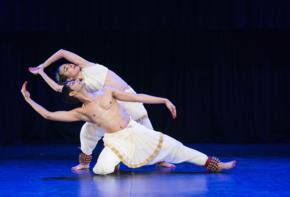Deconstructing bharatnatyam

The audience settle on their seats in the Q Theatre. It is 7:05 p.m. on a breezy Saturday evening. The crowd murmurs as the curtains go up and two classical dancers dressed in cream-coloured cotton garments with golden stripes, also called Kara in traditional Kerala dressing, appear on the stage. With shades of blue and white light on the backdrop and a spotlight on the duo, the dancers perform to Sanskrit chants reverberating through the venue.
Intellectuals, patrons of art and classical dance enthusiasts had gathered last week to witness one of the finest dance performances in the southern hemisphere. Govind Pillai and Raina Peterson took the audience on an hour-long journey of visual meditation with their deconstruction of the ancient dance form. Earlier this year, In Plain Sanskrit had sold-out shows in Melbourne and Sydney. Both Govind and Raina reside in Australia and have been performing in different art festivals across the world.
The show brought a fusion of classical Bharatnatyam and contemporary dances, choreographed like a storm of natural flavours minus the unnecessary added spices. A complete deconstruction of the add-ons such as jewellery, ornaments, props or exaggerated moves.
The simplicity of the dance was visible from the attire of the performers, who were clad in a simple cotton garment instead of the traditional heavy silk costume with jewellery and make-up to highlight facial features.
The platform had three silver pots (kalash) filled with water, scattered flowers and a mud pot with wheat flour used as props for the dance. Govind emptied the mud pot and the duo drew a rangoli on the stage, only to later smudge it. Rangoli represents a beautiful creation and messing or defiling it means provoking ancient beliefs and defying the custom. The idea to smudge the rangoli was to break stereotypes, challenge the norms and do something unconventional.
The music of the show was given by Venkat Ramakrishnan, Kersherka Sivakumaran and Pallavi Susarala along with Kav P, who played the Japanese taiko in synchronisation with the music and steps of Govind and Raina. This gave the performance a new dimension—an experiment that the dancers have been working on and improvising with every show
“I have witnessed one of the most soul-liberating forms of artwork today. It was so spiritually uplifting and connecting,” exclaimed one from the audience.
More than 70 per cent of the viewers were Kiwis and their curiosity about the dance and the dancers was evident at the Q&A session after the show.
The show ended with a standing ovation and a thunderous applause.




